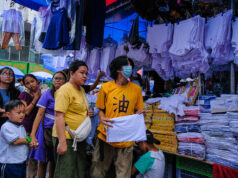Mindanao still competitive despite security, issues — NCC
THE National Competitiveness Council (NCC) said that parts of Mindanao remain competitive despite slower economic growth this year, with certain cities in the region maintaining high positions in the Cities and Municipalities Competitiveness Index (CMCI).
NCC Co-chairman Guillermo M. Luz told BusinessWorld that big cities in Mindanao continue to outperform parts of Metro Manila.
“Certain cities in Mindanao… have stepped up and they are among the most competitive cities in the Philippines. I see Davao, I see Tagum and I see Cagayan de Oro City, General Santos City [having high ranks in the index],” he added.
“There are places that are doing well and the towns are doing better. So, it’s a case of getting more and more of them to get competitive among the other cities.”
Mr. Luz said large cities in Mindanao are seeing improvements in educational attainment, better access to water, and a decline in poverty rates, all criteria used to measure local government units in the CMCI.
In rankings released in August, Davao City was the third most competitive highly urbanized area in the Philippines according to the CMCI, inching two notches up from last year’s 5th place and maintaining its position in the top five for four years.
However, none of the other cities in the Davao region made it to the top 10.
Tagum City was in 21st place. In the most competitive provinces category, South Cotabato ranked second.
While pockets of Mindanao are seeing stunted economic growth, Mr. Luz added that President Rodrigo R. Duterte being from the region helps put Mindanao in the spotlight and may cause investment to trickle southwards.
“As far as people are concerned, he came from a metropolitan area so it brings a lot of attention to the place and that’s a good thing,” he added.
The Board of Investments said last month that based on 10-month investment pledges data, south-central Mindanao, the island’s leading region for investment pledges ranked sixth nationwide.
South-central Mindanao includes South Cotabato, Cotabato City, North Cotabato, Sultan Kudarat, Sarangani and General Santos City, which a 31.98% decrease in investment pledges year on year to P14.27 million.
Northern Mindanao was ninth nationwide with P7.06 million worth of investment pledges, down 27.91%, followed by the Davao region at P5.09 million, down 38.34%.
The Caraga and Zamboanga Pensinsula regions were ranked 13th and last nationwide, respectively, with Caraga investment pledges at P1.35 million, with no comparative data available from a year earlier, while Zamboanga Peninsula accounted for zero in the 10 months to October.
The depressed investment climate was blamed on the Marawi siege.
Mr. Luz said that every area has its challenges, with the biggest issues overall being infrastructure and utilities. He also noted that security concerns also affected overall investments due to generalizations about the whole region being unsafe.
“The government wants to help but obviously it has limitations. Credit, for instance. I don’t think that can come from the government but it can come from the banking system,” he added.
“Connectivity, Internet, e-commerce — all those types of things will have to be provided by the private sector. I don’t think the government is in the position to supply everything.” — Anna Gabriela A. Mogato



